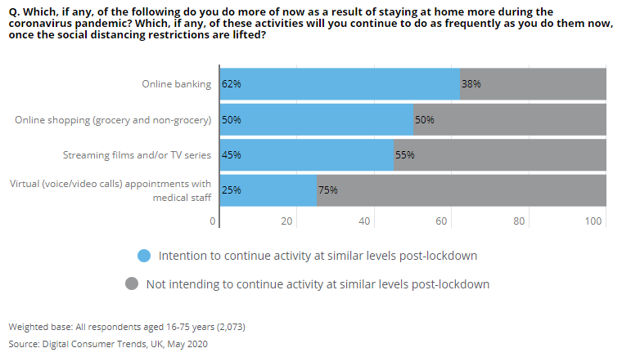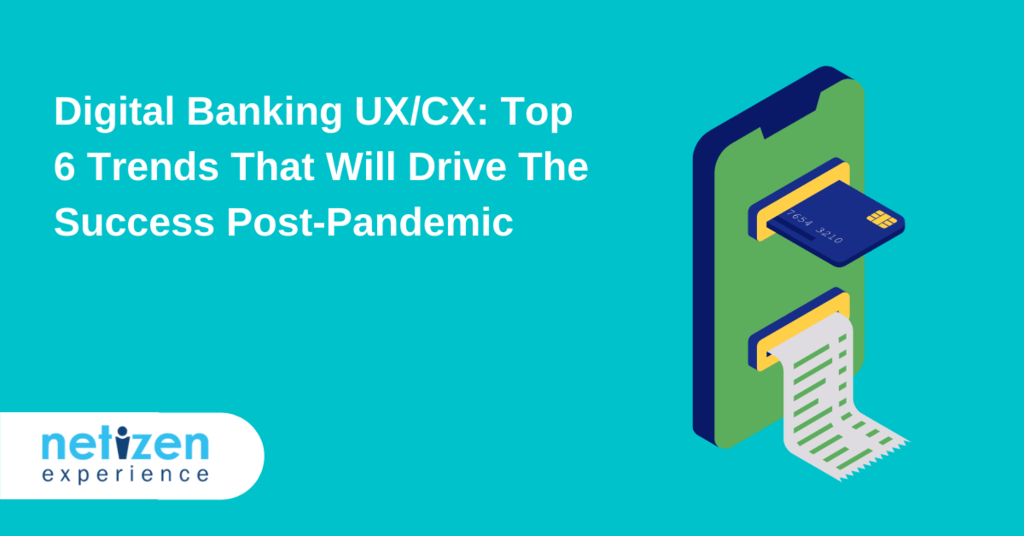[et_pb_section fb_built="1" admin_label="section" _builder_version="4.16" global_colors_info="{}" theme_builder_area="post_content"][et_pb_row admin_label="row" _builder_version="4.16" background_size="initial" background_position="top_left" background_repeat="repeat" global_colors_info="{}" theme_builder_area="post_content"][et_pb_column type="4_4" _builder_version="4.16" custom_padding="|||" global_colors_info="{}" custom_padding__hover="|||" theme_builder_area="post_content"][et_pb_text admin_label="Text" _builder_version="4.17.3" background_size="initial" background_position="top_left" background_repeat="repeat" hover_enabled="0" global_colors_info="{}" theme_builder_area="post_content" sticky_enabled="0"]
The pandemic has created a monumental emphasis on the significance of digitalization, affecting the banking sector that hasn’t been well-digitized for the most part. Poor digital banking UX/CX remains the key competitive advantage for banking players.
A study by Deloitte UK reports that digital banking services were used more during the pandemic, led by a surge of six million new adopters in April 2020 alone. The optimistic trend observed during this pandemic may even prove to be enduring, especially for digital banking services.
[caption id="attachment_2257" align="alignnone" width="622"]

Attitude towards usage of digital banking post pandemic[/caption]
With this uptick of digital migrations comes the need to emphasize on a positive digital experience to retain the momentum in a post-pandemic paradigm.
Here are the top 6 trends that will drive the success of digital banking post-pandemic:
1. Staying Connected
The success of any digital transformation is often built on a customer-oriented mindset. Even a well-strategized initiative would flop when the primary focus shines elsewhere, especially during the pandemic.
Being on a virtual platform meant that a connected digital experience was no longer a convenience but a necessity. Salesforce’s numbers tell us that 66% of customers expect companies to understand their personal needs and expectations. Disconnected experiences have always inconvenienced customers, but the damage is often worse in a digital environment.
By integrating a user-centric approach, banks are poised to witness more sustained growth from their digital initiatives in a post-pandemic environment.
2. The Need for Personalization
For many services and products, their digital experiences are often built for mass adoption, which makes excellent business sense in most cases. However, when the digital tool involves a degree of sensitivity, such as real-time money management, it often calls for a greater depth of personalization.
TD Bank approached this challenge through personalized cards within their app that changes based on the user. “If a customer is not digitally fluent, then the cards we render to them would be very different from that of a power user. We want to slowly graduate them to useful digital experiences,” says TD’s chief digital officer Rizwan Khalfan.

Image: TD digital banking app UX personalization
The TD app also provides personalized real time money management based on the user’s current spending trajectory. The app would alert the user about possible financial risk and give personalized suggestions about what the user can do about it.
This approach to personalization has worked wonders for the bank, especially considering that a significant portion of their newcomers had never used digital tools of any kind. Banks should work towards humanizing the digital experience, and not the other way around.
3. Contextual UX Approaches
Crash course: A contextual UX refers to approaches tailored to the individual user’s unique needs based on their specific situation or context of use. Nothing screams personalization more than a tailored experience.
If there’s one thing customers love about digital banking UX, it’s their ability to get to what they want without a queue. And implementing a contextual experience helps solve the customers’ problems in the quickest way without bringing them through a standardized path.
The sky’s the limit when it comes to providing a contextual experience, but here are some basic checkboxes that a digital banking UX should tick:
- Alert users about tasks or reminders that would require their attention, such as reminders to pay certain bills when it is near to the end of month.
- Provide suggestions on improving the user's financial health by monitoring their spending habits.
- Understanding the users’ needs and goals, and to provide realistic financial forecasts and craft unique bank offers based on them.
Sounds like a simple way to kick things off, doesn’t it? Contrary to what some may think, you do not need to be Facebook to provide a well-contextualized experience; a better understanding of your customers would go a long way.
4. Bridging the Gaps of Empathy
As digital tools begin facilitating access to significant decisions with a single click, communication becomes the first and last line of defence. With the right amount of emotional connectivity embedded, new customer expectations would eventually point towards digital channels as their first and last interaction layer, especially in a post-pandemic paradigm.
Loyalty, empathy, and emotional connections have long been the cornerstones to a solid bond between financial brands and their customers. However, it’s not often that empathy gets tied to conversations surrounding digital banking UX.
Aside from personalizing the pages of content displayed upfront, one needs to ask about the level of empathy built into it. In short, customers want to feel like they are being treated as a human being and not just a number amongst the bank’s customers. This is also why many banks have now increased their investment into CX or UX research significantly to ensure that they infuse human insights into their digital product development, as opposed to developing digital products based solely on the bank's business requirement. By investing in UX research, it helps the banks to lower the risk of not empathizing with their customer.
5. Experience-Driven KPIs
We’ve established that a positive user experience differentiates a successful digital banking UX from failures. With a stronger emphasis on the digital experience, it’s a no-brainer to highlight the Key Performance Indicators (KPIs) that evaluate the users’ experience. The use of KPIs will continue to help the bank to measure the continuously evolving customer expectation in the post pandemic era.
Here are some specific KPIs that banks could use to help understand their customers’ pain points:
- App ratings and reviews on app stores, social media platforms, and forums.
- Customer retention and switch rates.
- Customers’ reasons for contacting the support centre.
- Customer Satisfaction Score (CSAT) to quantify the customers’ level of satisfaction.
- Net Promoter Score (NPS) to evaluate the likelihood of customers recommending the product.
- Customer Loyalty Index (CLI) to measure the strength of a customer’s loyalty towards a brand.
- Customer Lifetime Value (CLV) to understand the value of investing in long-term customer relationships.
6. Consistency is Key
When banks digitize their products separately, there would be some form of fragmentation within the usability, information architecture, and at times the interface itself, leading to a broken customer experience. So how can banks get it right?
A unified vision can be achieved by ensuring that everyone within the ecosystem receives real-time information and are always on the same page. According to Salesforce, 76% of customers expect consistent interactions across departments, providing a holistic flow across different services. For banks to deliver a consistent digital experience, they need to stop looking at their digital channels as an alternative form of service delivery, and start accepting that it’s here to stay post-pandemic.
In addition, having a unified design system that is followed throughout the organization would also help to reduce such fragmentation.
Wrapping Up on Digital Banking UX/CX Trends
The tricky thing about user experience is that the tide of customer expectations constantly rises, and only the best digital experiences stay afloat. In fact, this coming generation of post-Covid customers will expect much more from digital banking UX, and banks should take this as an opportunity for accelerated growth.
As Microsoft CEO Satya Nadella put it, “We’ve seen two years’ worth of digital transformation in two months.” Industry players who stay behind the trend will eat dust from the monumental shift in customer expectations. And what better way to stay on top of these CX/UX trends, than to sign up for our newsletter?
[/et_pb_text][/et_pb_column][/et_pb_row][/et_pb_section]





